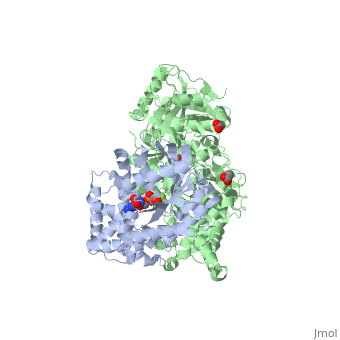Introduction
Phospholipase C beta 3 (PLC-β3) catalyzes the hydrolysis of phosphatidylinositol 4,5 bisphosphate (PIP2) to the second messengers inositol 1,4,5-trisphosphate (IP3) and diacylglycerol (DAG) in an essential step for many physiological cascades. When the receptor stimulated by ligand of some kind, it increases exchange of guanosine diphosphate (GDP) to guanosine triphosphate (GTP) on Gαq. GTP-bound Gαq activates PLC-β3, and PLC-β3 increases up to three orders of magnitude the rate of hydrolysis of GTP by its activating G protein. This is a unique mechanism in which PLC-β3 enzyme has the ability to terminate the Gαq protein signal, in addition to being activated by it[1][2].
Structural highlights
Overview of the PLC-β3 and Gαq interface:
The Gαq subunit consists two domains, one is and the other is . These domains include three regions called .These regions allows the Gαq to be released from the receptor and activate distinct downstream effectors, which carry on the signal to downstream targets. A central effector of Gαq being the PLC-β3 enzyme. The switch regions I and II interact with several domains in PLC-β3.
consisting of N-terminal PH domain, a series of four EF hands, a catalytic TIM barrel that the X/Y linker connect its two halves and a C2 domain.
PLC- β3 engages Gαq throughout three regions. First, an extended loop between the third and fourth EF hands of PLC-β3 directly supports switch residues critical for GTP hydrolysis by Gαq. Second, the region of PLC-β3 that connects the catalytic TIM barrel and the C2 domain interacts with both switches 1 and 2 of Gαq. Third, a segment composed of a helix-turn-helix at the C terminus of the C2 domain mostly located within a shallow declivity on the surface of Gαq formed by switch 2 and α3.
Local motifs in Gαq-PLC-β3 interactions:
between the end of the TIM barrel and the beginning of the C2 domain comprises a second distinct segment of PLC-β3 that makes extensive contacts with active Gαq, including switches 1 and 2. This interface includes a series of interdigitated pairs of charged residues, specifically in PLC-β3-Gαq Asp709/Arg202, Lys710/Glu191, and Asp721/Lys41; these in turn are supported by additional charged residues Glu703 and Arg707 of PLC- β3.
between EF hands 3 and 4 of PLC-β3 interacts with the GTP-binding region of Gαq. Asn260 of the EF3/4 loop promotes GTP hydrolysis by interaction with the side chain of Gln209 of Gαq, which rearranges during GTP hydrolysis to stabilize the transition state mimicked by GDP•AlF4–•H20. Asn260 also interacts with Glu212 to stabilize switch 1 for GTP hydrolysis.
Other effectors are known to engage Gαq throughout . In addition, there are a large family of regulator of G protein signaling (RGS) proteins that independently accelerates the GTP hydrolysis, these RGS proteins engage the GTPase domain throughout on Gαq. PLC-β3 interacts with on Gαq that overlaps almost completely with portions of Gαq needed for engagement of RGS proteins and other effectors[1].
Critical residues in the interface:
The canonical Gα effector-binding region of Gαq, located between α3 and switch 2, is occupied by a helix-turn-helix (Hα1/Hα2) that immediately follows the C2 domain of PLC-β3. of PLC-β3 lies within the turn between Hα1 and Hα2, makes extensive contacts with multiple residues of Gαq, and forms the center of a Gαq-binding interface.
is located at the active site of Gαq as part of a tight turn of PLC-β3 that is stabilized by Glu261 and underpinned by an extensive series of hydrogen bonds principally mediated by Asp256, Arg255 and Arg258. These residues are highly conserved in all PLC-βs, as are Asn251 and Leu267, which appear crucial in stabilizing the ends of the loop.

